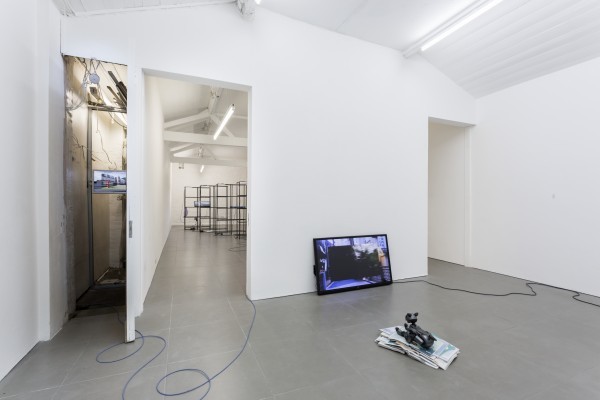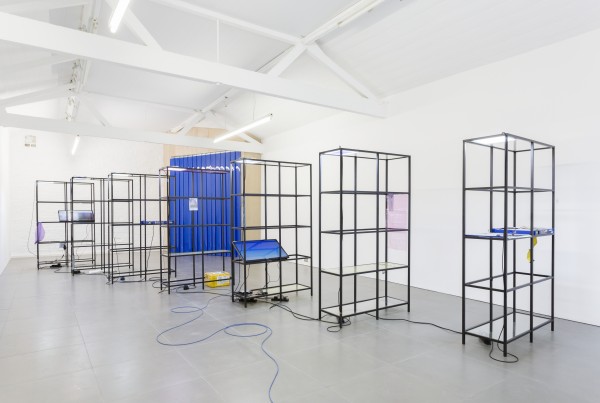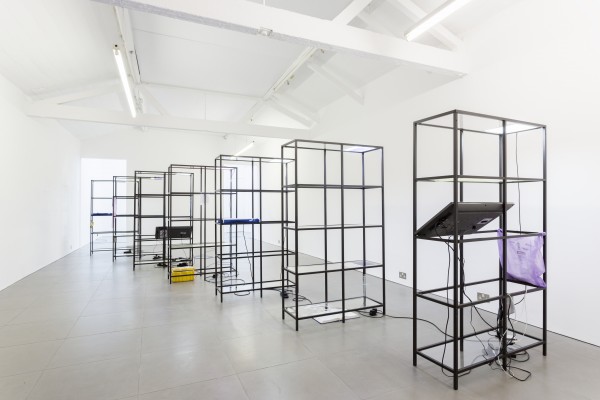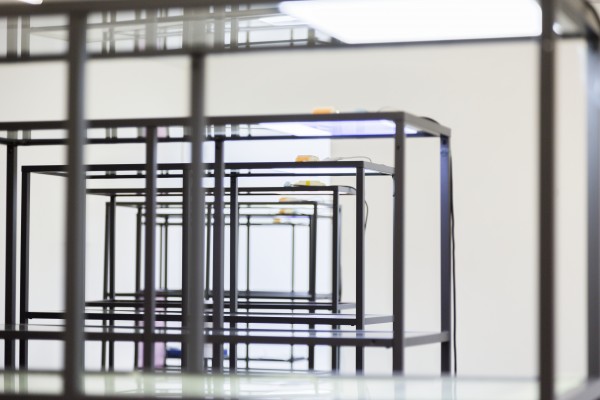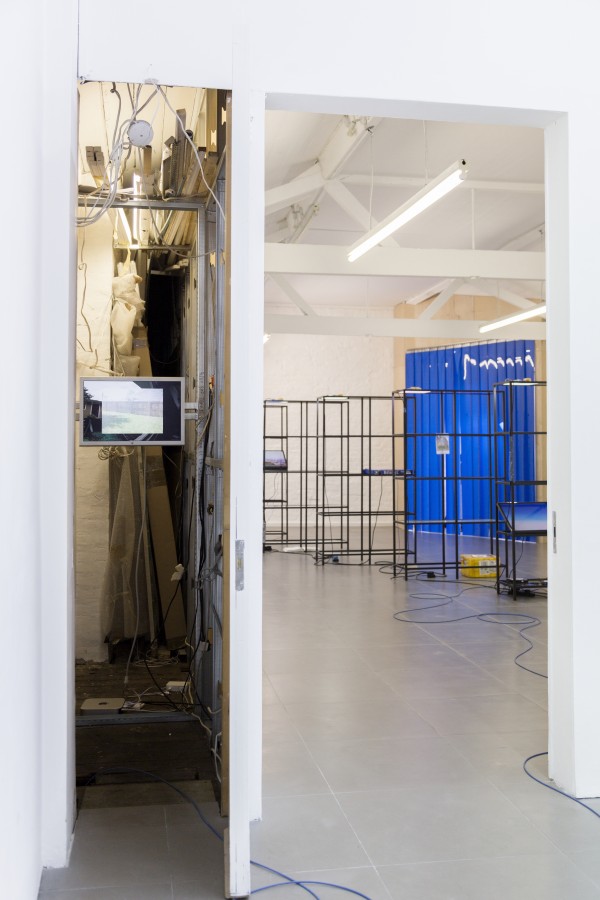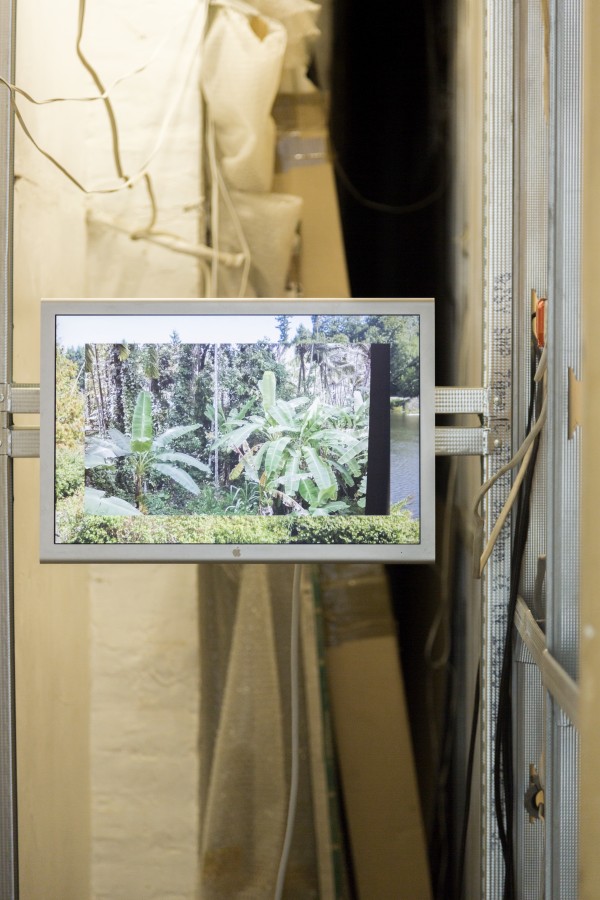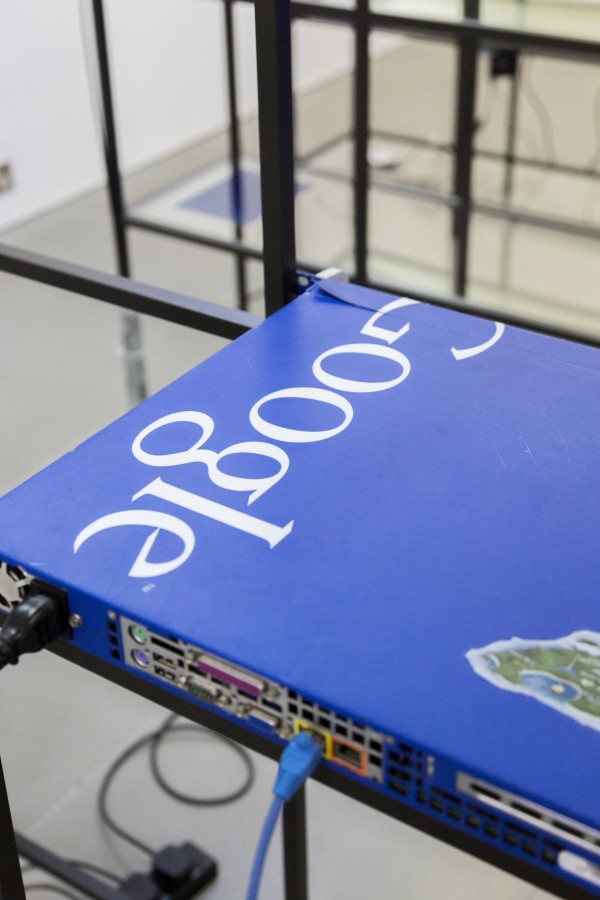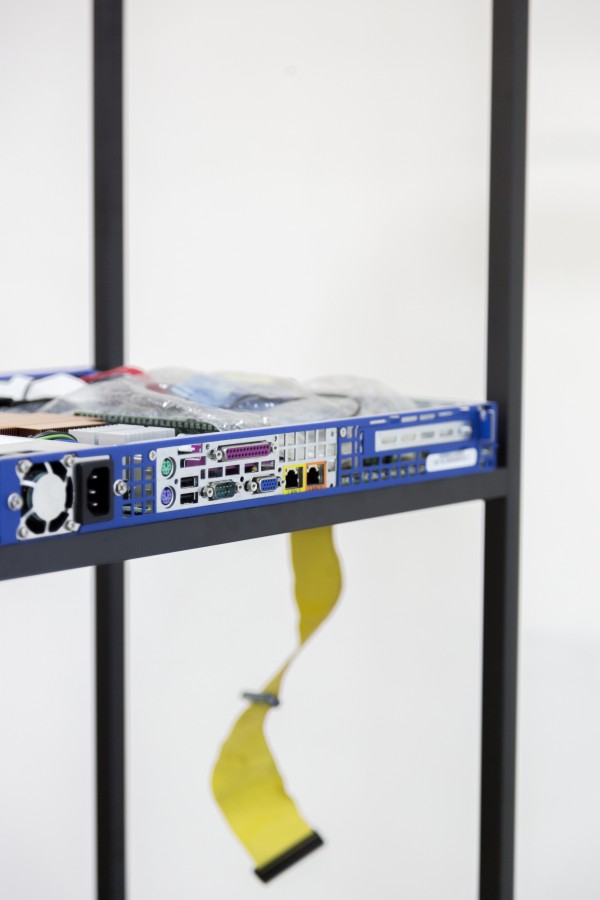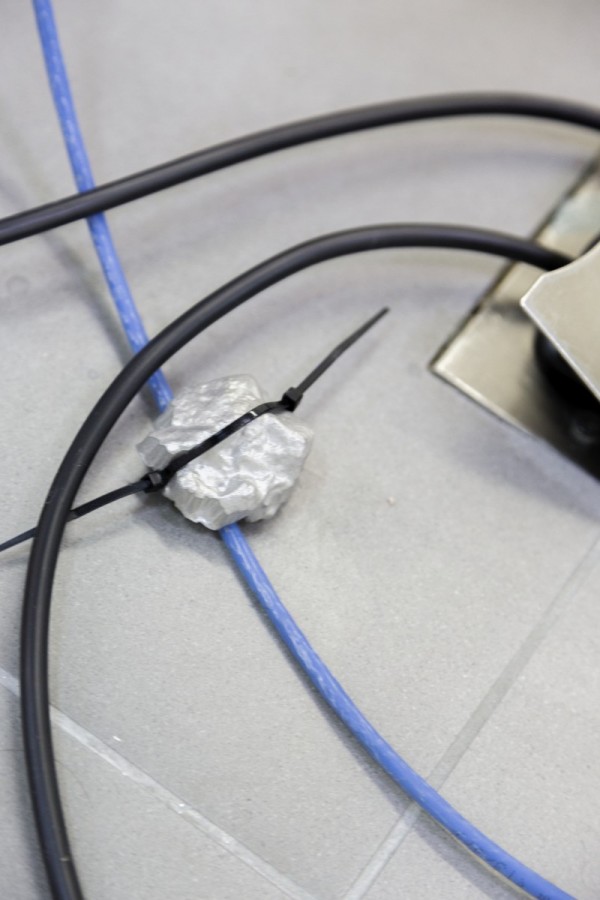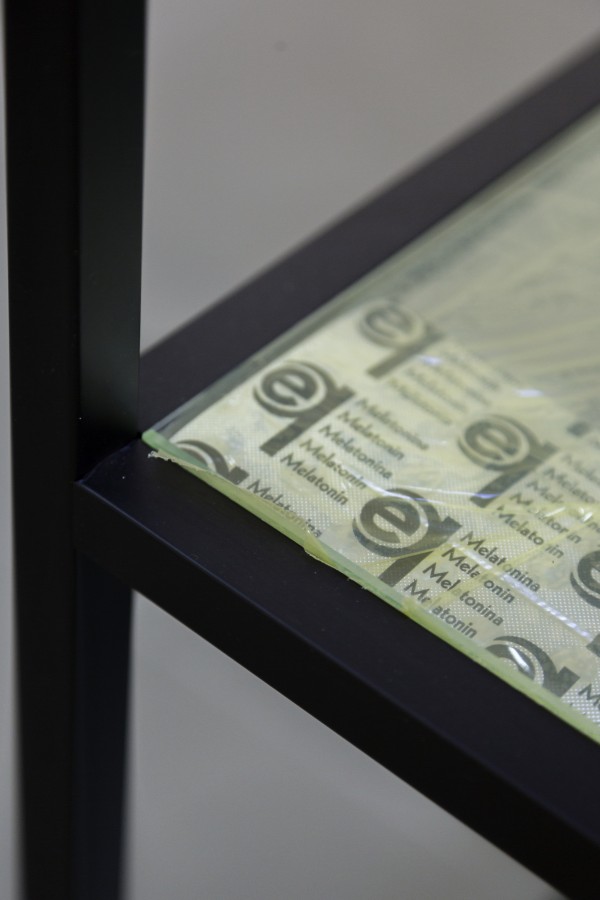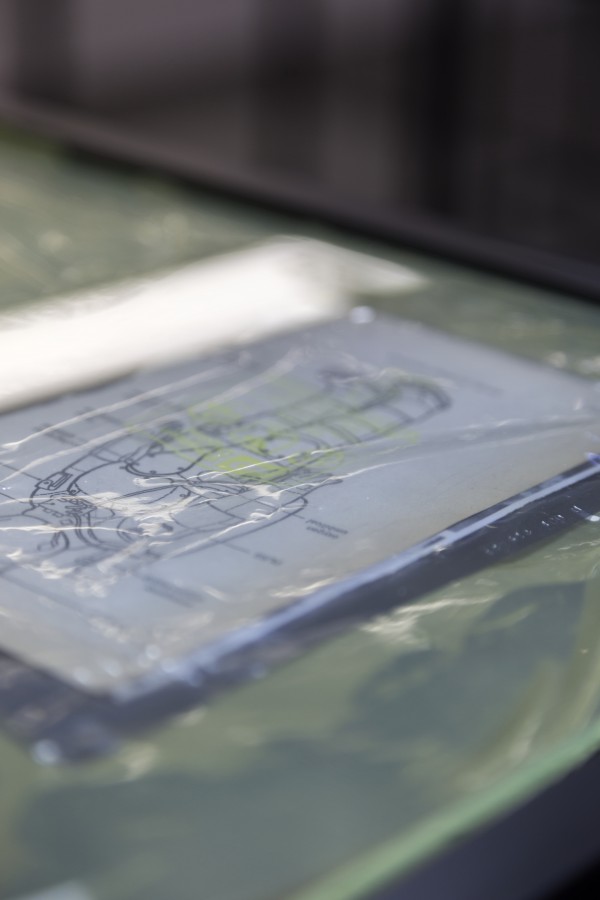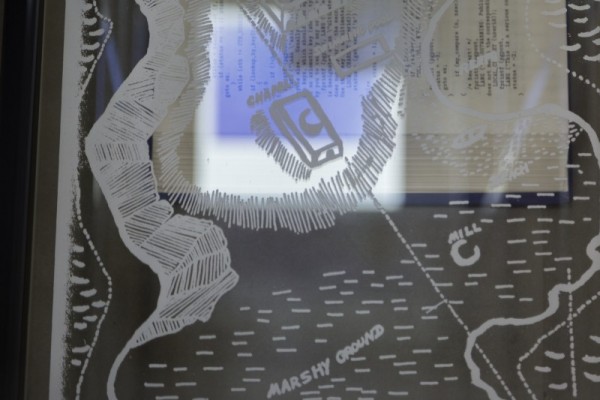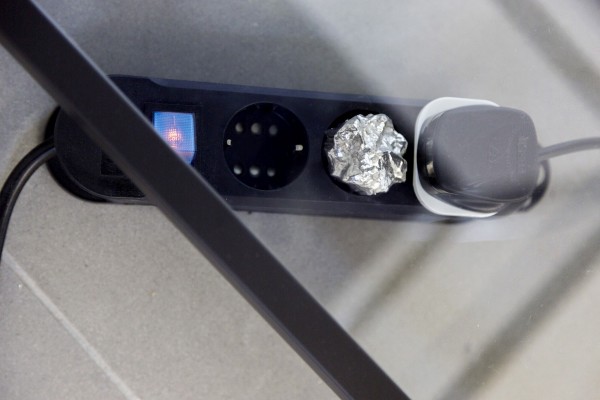Lafayette Anticipation associate curator Anna Colin talks to artist Tyler Coburn about Ergonomic Futures, a speculative project engaged with art, design, science, anthropology and writing. In this interview, Coburn discusses the research, production process and network of collaborators of a multilayered project ultimately concerned with the futures of humankind. Anna Colin: When one comes across your museum seats Ergonomic Futures (2016—) in contemporary art exhibitions—and soon in natural history, fine art, and anthropology museums—they look… [read more »]
Yuri Pattison | Free Traveller at Cell Project Space
A companion text to Yuri Pattison’s Free Traveller at Cell Project Space by Nora N. Khan
I wake up to the snap of a cable along my neck; the fans have lulled me to sleep at my post yet again. The sleep aid they’ve dropped for us is working my brain too well. A thread of drool wraps down my wrist onto the glass and has made its sure drop to the floor. My shift friend, Henrik, a Dane, grins at me over his shoulder as he walks to the hold.
–Clean that up, he laughs, and pries open the vault door into data storage. Emerald green and ultraviolet lights stripe, cut his neck and his back.
I’m writing here now, because they want us to stay somewhat sane. I’m not sure what I’m supposed to be feeling. They left these logs along with clear instructions for weekly upload. I work alongside Henrik and four others.
This week, a group of workers disappeared into the ravine along the island’s east end. The idea of leaving the hangar, its heated walks, its bars and baths and whirlpools, is appalling to me, but I also spend seventy hours each week here babying the servers in a starched uniform. The time I have off is precious.
I chose this work, which baffles most everyone. I chose to live in a pod house branching off the data center. I chose to work in this room, this locus from which I can watch the blistering scroll of the central news wires, the report logs of hired law as they upload to the mainframe, the closed circuit feeds peering on every corner of the island. I chose to listen to the hundred thousand signal clicks from ports, ships, banks, exchanges and markets, legitimate and not, across the world, pouring in by the hour.
Along one wall, a hundred screens stream millions of images each moment: Alfred Schantzer III loved the cycle from eye to film to code back to eye again. His crest was a smiling, happy-eyed ouroboros, emerald green, frozen in a field of blue. Every news digest he sent out bore the stamp of the cheerful snake.
And the truth was, I wanted to be alone, after what many of us had seen. Now, I can barely describe the years of decline to another islander, the riots, the inchoate mess of loss. I just knew, at its end, that I wanted to be alone and at peace and in a place my system would be padded away from any more shocks.
I had seen the fields of my home state filled with trash; schools were holds for dead animals before burning, and the air everywhere smelled of a deep rot that has never really cleared from my memory.
On the plane, and then on the boat, I imagined all the debris of my life left behind me in our wake. Our family house, my schools, my work, the cities, my friends, lovers – all of it frozen into a shrine, on a pallet that floated off to the horizon.
Our arrival on shore: a clean break to give myself over to the future.
I walk down the line of cooling vents punched into the floor. I run my right hand along each tower as I tick past them, the slim servers stacked ten high: ten by ten by forty at the last count, just about 4000 servers to buoy and sustain this 18-square mile island in the glittering tenth trade quadrant of the South Pacific.
ENTRY TWO
Schantzer III joked that the island was forever. With enough time here, you begin to understand his meaning. In the generators I hear the gentle, steady, humming nodes of a self-sustaining, self-contained machine. All waste feeds into material for our food and fuel. We can grow nearly every plant and we mostly do, and the lack is brought in to the port within each day’s end. No taxes, no limits on trade. No surveillance, no dominion, no overlord.
I have an hour free. I get on the small bullet train. The ride around the island is a three minute loop. The smooth curve of the bullet’s sound thickens, layer upon layer of acceleration pressing me back into bliss. Each car is floor to ceiling glass and sits at a slight angle, tipping us out a bit onto the ocean. I see the conductor’s white gloved hand deftly switching between panels.
I turn my head in towards the island, and practice letting my eyes float on the chaotic tangle of trees in the middle distance. Houses bleed together into a single deep gray stripe. Hills move slow in the distance.
Back at the center, I walk out onto the curved, wide, bleached path. The psychic weight of the white building presses along the length of my neck and my side. I wander up into the glass hangar. From the deck, I watch the specks of people in the monstrous wave pool, the size of two, maybe three, city blocks. The dome’s UV glass protects us from the island’s brutal sun.
I see Mara, a shift friend, attractive enough in a green suit, spinning on a floral floatie about a thousand feet down. She wears huge sunglasses, so I can’t discern her mood. Clusters of adults bob and bounce in circles, talking. Still others stretch their legs out on the concrete, looking occasionally up from their newsfeeds to the sea beyond, thinking of images scraped from Australia and China. Most of us linger here in the dome, and most of us work while relaxing. Speculators trade, haggle, bet online, make a kind of art of it.
I haven’t seen the planner in some weeks and feel starved for her. We either meet here by the pool or, as today, on the wood deck. I find her sunning and languid and as always, unreadable. Our understanding seems slow, certain and real. You need things like that here, or the body tends to dislocate and float off of its own accord.
She greets me and pulls her plans, crisp, beige scrolls, out of her bag. We read the plans between us in the sunshine and I try to focus on her drawings and not on her hands, which are beautiful, the veins thick and high. She has visited thousands of cities in four years. She is alive. She tells me how she falls asleep watching the plane’s lights cut thin beams across the cloud bed and wakes to clouds.
The owners plan to expand the luxury resort. More cabanas and more dance halls. They will soon move her to the next seastead.
–All these people, she says, gesturing at the panoply before us. All these people are without their own people. What else can we do except make it feel as good as possible?
–Well, this feels good, I say, and feel like a fool, as I should.
I see she is no longer looking at me, but up through the zenith of the dome to the blind white sky.
I think about her coasting through a range of chromatic blues, sustained between pantone and azure, rising up to the space between midnight and Egyptian blue, high into black, true space. How she probably counted the rifts and blue canyons and striations of ice like tendons in blue flesh below her, not a human in any of it.
ENTRY THREE
From my bed, I can still hear the pulse of the club, a brush of light waves that prickle my face. I’ve just come from there. There was a minor failed despot at the bar, his thick bloat pressing through his checked oxford, his eyes bleary with memories.
My room is sparse: clock, table, bowl, wash basin, heated floor, white curve of the ceiling. They’ve designed each room to be like the womb, so no one can hear you shout or even scream. People abruptly run out into the night from some pods and the sight of them for the first time, running bare legged across the deep black green lawn, is still shocking.
The center’s floor this morning is thick with waste: packing envelopes from the flight drops of the first quarter, slips from qatartoworld.com on every surface. On the glass, I find a mound of hard to find skullcap and my drowsy pills. Mara and Henrik have both been suffering.
I see Mara emerge from cold storage, looking dazed. She shuffles along the newly waxed floor, singing quietly, Once in a lifetime! Water flowing underground.
I smile at her, then watch the law search feed with some interest. A meager, sweaty team has been sent out to find the lost workers. We watch their body cameras as they stumble and shudder through the undergrowth.
I meditate on the rotating disc on my watch face, which passes intervals of five seconds: 5, 10, 15, 20. Inscribed in delicate black, in Russian: Made in the USSR – G43 – Chistopol – the location of the watch factory.
The Sputnik watch was Schantzer’s favorite gift to give. (This one was left behind by the last server manager). He was obliquely interested in Soviet iconography, and collected original space program posters, offensively cheery renditions of man with nebula. He bought as many authentic Sputnik watches as he could. But he was interested in Russia the same way he was in all newer experiments in government: Cuba, New Harmony, China, Iran.
This light, mercenary interest is probably what allowed him to amass his billions. He invested in prison industrial stocks as easily as he did in corn futures. Everything, for him, was material. Nothing like a romantic place to stay,
ENTRY FOUR
The headlines have become more uncanny, and alarming, over the past few days.
Nobody harm as aircraft crash lands in golf course pond
Origin of Grounded Barge in Palau’s Southwest Islands Uncovered
Peter Quill, the boy wanderer
Peter Quill. Peter Quill?
After stealing a mysterious orb inside the far reaches of outer space, Peter Quill from Earth, is now the first aim of a manhunt led by the …
Out on the concourse, women are roasting and reading about Peter Quill. Above, the clip of several helicopters. There’s been abstract, loose talk of shortages and two infections, today, but nothing permanent. The sound is enough to make some come out of their pods to look up.
I watch a little boy and girl on the sun deck, playing with a robot dog, a cheap knockoff of the original Sony model. It toddles back and forth between each, looking up for direction. The boy turns the dog back to the girl. She turns it back to walk to him. The shadow of one helicopter, then another, moves over their game in silence.
I look for the planner among the women on the concourse with no luck. I float back down to the center on a cloud of vague unease.
ENTRY FIVE
Out this deep in the lowlands, I am bit by a hundred sloppy things I can’t identify. I felt one bird-sized spider tap on my shin and I howled. Ran. I am covered in sweat and feel like an open, weak, bleeding wound, calling to whatever beasts are out here.
I have needed this time away from the center. I was feeling set like a weird, numb, gem in concrete. I needed to move.
But the air is real and thick and it chokes. I part through mosquitoes by wind-milling my arms. This way, I break through to the ocean.
I hear and see and smell the thick, lush chaos of the port at once.
Along a half-mile, steamers, tankers, fishing boats and cranes all jockey for space. I swim in the frantic shouts, hollers and whoops of the hundreds who make their living down here. I walk through the godowns, see fishermen bent over intense discussion in swept coffee houses.
I am looking for Jeremy Van, and he is hard to miss, 6’5”, in overalls but no shirt, pulling down a haul of what looks like hundreds of old computer parts from a cargo bay. He is ecstatic. He brings me to his home where we drink his bitter yerba mate.
–Still keeping track of every square inch of this hellhole?
–Well. The computers do everything. I’m not retaining even 1% of it.
His friend, Lucas, a dock worker squint-eyed from working in the sun, joins us. We start in on the headlines.
–The news pieces are all scraped now, Jeremy says. The servers. We’re pretty sure several are set up to invent headlines for the island.
Lucas looks at me closely.
–We bring in news from all over, directly, he says. You know this, right? You know nothing comes to you without being filtered ten times through, right?
–That bullshit is then spun and spit out to you, Jeremy says, and stands.
-Of course, I say, and I laugh. I work in data.
They laugh, and believe me.
–Most wouldn’t believe what is actually happening out there, Jeremy says.
As Jeremy walks from the dark part of his kitchen into the sunlight, his face and whole body now oriented towards the sea, I feel cold in my core. I also feel like his single movement from dark into light, from facing inwards towards me to facing the salt air and brilliant open water, reorients my own mind.
I think back on the past weeks: I have trained myself to not look at the ocean on the train; I look away from distressed people running out of their pods; I stared at the planner’s face rather than following her line of sight out the glass dome.
ENTRY SIX
This morning I sliced the fleshy padding of my forearm on the razor edge of a dismantled hard drive. I brought my bloody arm to the hospice, where the nurse cleaned me, then took me out into the terrarium. He broke off a stem of aloe and pulled the leaf’s cold gelatin across my cut.
I have been living in this Spartan, anemic state between the center and my bed for so long. I cannot tell you how much time has passed. I can barely remember how I decided to enter the lottery for the island.
I come back in to the center and study the servers’ casings. I find the group of shelves earmarked for media. I pull one down, run my fingers across its surface.
The image of our island’s map, which I always thought was printed on the metal, stops my touch. It is a decal. I use Sputnik to crisp and lift the edge. I find, engraved into the case, these words. As I read them, I feel just how completely frozen the bunker is:
Here we live in the future, eternal! No memory makes for no pain, and my life’s greatest joy is that I can pass this truth on to you. Enjoy yourselves! Always enjoy yourselves.
Yours,
Alfred Schantzer III
August 2026
Beneath the date, a cryptic quote, source unknown:
In the thrall of wires, network, omniscience – the pull, the grant, of paradise.
Yuri Pattison
Free Traveller
Cell Projects Space
17 Sep 2014 to 2 Nov 2014
